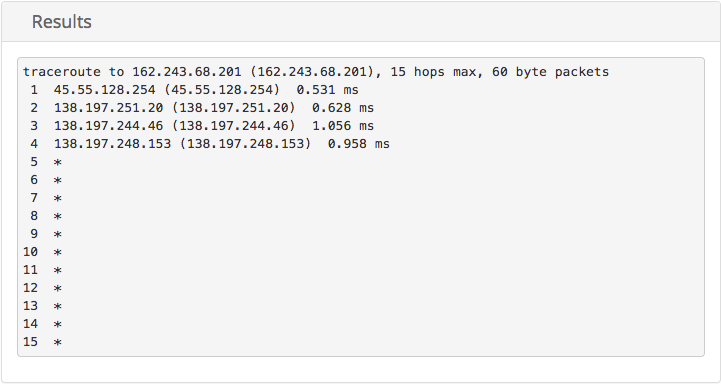
Resources:

Categories:
Book a Free Demo →
Want DNS Freebies?
Give us your email and we'll send you the good stuff.

Categories:
Emil is a Marketing and SEO Expert at Constellix. If you found our site online, you can thank him for getting you there.
https://www.linkedin.com/in/esimeonov/
In this guide, we will be using Sonar Lite (web app) to troubleshoot common network issues. If you want to follow along, be sure to have the Sonar Lite web app open in your browser or on your mobile device (iOS and Android only).
Who is this for?
We designed this guide for network admins, sys admins, and support technicians. If you deal with the Internet on a daily basis, most likely you will (or have) run into one of the issues we're about to troubleshoot.You may notice that some of these commands are a lot like the dig terminal commands. While they are easy to use, Sonar Lite lets you share your results with team members with unique links for every result.
What is Traceroute
Traceroutes show you every hop between your browser and the hostname you want to connect to. If you are unable to reach an end-point, you would want to run a traceroute to identify which hop is experiencing issues.Traceroutes are configurable by IPv4 or IPv6 address, port, and location.In this example, we are looking at how many hops are between my browser and the constellix.com website. The traceroute shows the IP addresses of the systems my query will hop across on its way to the endpoint.

Most end-points are a hand full (even dozens of) hops away from the browser, so there are many possible points of failure.
Pro Tip:
Traceroutes can be run from various locations to help you pinpoint location specific issues. So if you run into a connectivity issue, check to see if nearby monitoring nodes detect the same change.
DNS Lookup
Want to make sure your record changes have propagated to your name servers? DNS Lookup is a great tool to check where specific records are pointing.DNS lookups are run directly at the authoritative name server (not a resolving name server). Since resolving name servers cache DNS information, your results may vary if your local cache has not refreshed yet.You can refine DNS lookups by location (great for any GeoDNS configurations) to test what endpoint your users in that location would be sent to.

In this example, we wanted to see where the MX or email records for constellix.com were pointing to. The results panel shows that we are using Google for our email services.
DNS Trace
Use a DNS Trace to see how your domain is resolved from your system (browser or terminal) to the name server authoritative for your domain.

On the way, you'll see results from the resolving name server, TLD (top level domain) server, and root name server. This is a great way to get full visibility of how queries for your domain are resolved.
If you want to learn more about how the different servers required to resolve a DNS query, check out How DNS Works.
TCP Check
A TCP Check, also known as a port check, allows you to verify connectivity of a hostname across various port and protocols. TCP, or Transfer Control Protocol, is one of the main protocols used to exchange information over the Internet --specifically for application programs.

Your result will show that the hostname is either UP or DOWN.
Pro Tip:
If you get a DOWN result, check to see if nearby monitoring nodes are receiving the same result. The error could be localized to only one area.
HTTP & HTTPS Checks
HTTP (Hypertext Transfer Protocol) checks are also known as "header" checks and status code checks. This is one of the most commonly used checks for web developers and designers. You can use this check to make sure your web server is responding.HTTPS checks or SSL checkers can help you verify your SSL certificate if you just added SSL or HTTPS certificate to your domain.

If your web server is responding, you will see a 200 status code. For additional status codes (like redirects and error codes) try the full version of Sonar.
WHOis Lookup
Not sure where you registered your domain? Need to know which name servers are authoritative for your site? Try a WHOis Lookup. This check accesses publicly listed information about domain registration.

Pro Tip:
Don't forget to renew your domain registration! Your expiration date is publicly available to the world, so it might not be yours if you forget to renew it.
GeoIP Lookup
You can use a GeoIP Lookup to detect where your query is resolving for your IP. This is great for testing GeoIP and other GeoDNS rules.

Let's say you want all of your end-users on the East coast to have their queries resolved at your New York PoP. You would want to run a GeoIP lookup (which is based on your current location) to ensure the domain is resolving at the right location.
Delegated Name Servers
Not sure what name servers you are using? Check the Delegated Name Servers to quickly see what name servers are authoritative for your domain.

If you are changing your DNS hosting provider or registrar, this is a great way to quickly ensure that your changes have propagated.

Need better DNS?
We can help.
• Configure with ease
• Prevent DDoS attacks
• Monitor your domains
• Optimize site traffic
• Enhance domain performance
• Free POC Account + Demo
BOOK FREE DEMO
Constellix DNS News
Sign up for industry news and insights. It'll be worth it.
Sign up for news and offers from Constellix and DNS Made Easy














